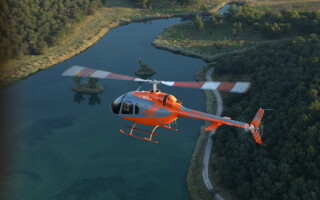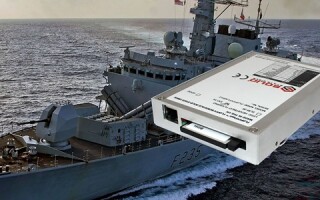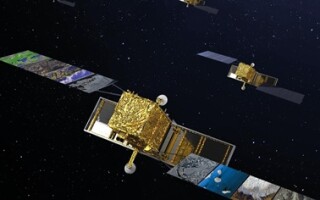DoD major program procurement and modernization highlights from FY 2018 budget request
StoryAugust 02, 2017
Funding requested for Department of Defense (DoD) Major Defense Acquisition Programs (MDAPs) for Fiscal Year (FY) 2018 totals $94.9 billion, more than $17 billion dollars over the FY 2017 request, making up 46 percent of the Trump administration's $208.6 billion FY 2018 acquisition budget request.
The acquisition budget request makes up about 33 percent of the overall FY 2018 DoD budget request of $639.1 billion – $574.5 billion in the base budget and $64.6 billion in the Overseas Contingency Operations (OCO) budget. This number is an overall increase of nearly nine percent over FY 2017’s $586.7 billion total.
The MDAP funding is detailed in the DoD’s “Program Acquisition Cost by Weapons System” booklet. Air, ground, and maritime platform program highlights are detailed below. To read the entire booklet, visit http://comptroller.defense.gov/Portals/45/Documents/defbudget/fy2018/fy2018_Weapons.pdf.
Major aircraft programs
Funding slated for major aircraft and related systems totals $49.9 billion under the DoD FY 2018 acquisition funding request, an increase of $4.6 billion from the FY 2017 request.
Aircraft and related systems funding includes procurement of 70 F-35 jets, 29 logistics support aircraft, 198 helicopters, and 50 unmanned aerial vehicles (UAVs). In addition, the funding in this category provides for the development of aircraft-related technology, the procurement of aerospace equipment and systems, various modifications to existing aircraft, and the procurement of initial spares.
Manned platforms
The F-35 Joint Strike Fighter (JSF) consists of three variants: the F-35A Conventional Take-Off and Landing (CTOL), the F-35B Short Take-Off and Vertical Landing (STOVL), and the F-35C Carrier variant (CV). The FY 2018 program calls for continued development of the air system and the F135 single-engine powerplant; it also asks for funding for systems engineering, development, and operational testing and supports follow-on modernization. Procurement for a total of 70 aircraft: 46 CTOL for the Air Force, 20 STOVL for the Marine Corps, and four CV for the Navy in FY 2018. FY 2018 funding requested is $10.837 billion, down from $11.323 billion in the FY 2017 request. (Figure 1.)
Figure 1: Several U.S. Air Force F-35A Lightning II aircraft assigned to the 58th Fighter Squadron, 33rd Fighter Wing, fly in formation following an aerial refueling qualification mission over Eglin Air Force Base, Florida. DoD photo by Master Sgt. John R. Nimmo Sr., U.S. Air Force.
The V-22 Osprey is a tilt-rotor, vertical takeoff and landing aircraft designed to meet the U.S. military’s amphibious/vertical assault needs. The FY 2018 program calls for funding the first year of a follow-on seven-year multiyear procurement contract (FY 2018 to 2024), procuring six CMV-22 aircraft for the Navy. FY 2018 funding requested is $961.8 million, down from $1.822 billion in the FY 2017 request.
The AH-64E Apache program is a parallel new-build and remanufacture effort, which integrates a mast-mounted fire control radar into an upgraded and enhanced AH–64 airframe. The FY 2018 program funds the remanufacture of 48 AH-64D aircraft to the AH-64E configuration and 13 new build AH-64Es in the second year of a five-year multiyear procurement (MYP) contract (FY 2017 to FY 2021), along with continued development of upgrades to enhance operational capabilities. It also procures two AH-64E aircraft in the OCO. FY 2018 funding requested is $1.441 billion, down from $1.840 billion in the FY 2017 request.
The UH-60 Black Hawk is a twin-engine, single-rotor, four-bladed utility helicopter designed to carry a crew of four and a combat-equipped squad of 11, or an external load of as much as 9,000 pounds. The FY 2018 program calls for funding the procurement of 48 UH-60M aircraft in the second year of a follow-on five-year MYP contract (FY 2017 to FY 2021). It also funds the continued development of upgrades to the UH-60L Digital, now designated as the UH-60V. FY 2018 funding requested is $1.059 billion, down from $1.352 billion in the FY 2017 request.
The P-8A Poseidon is multimission platform designed to replace the P-3C Orion propeller-driven aircraft. The FY 2018 program procures seven P-8A aircraft, support equipment, spares, and advance procurement for FY 2019 aircraft. It also continues research and development on the P-8A capabilities to meet the anti-submarine warfare (ASW); anti-surface warfare (ASuW); and intelligence, surveillance, and reconnaissance (ISR) objectives that will be delivered incrementally while full-rate production continues for the baseline aircraft. FY 2018 funding requested in this area is $1.609 billion, down from $3.267 billion in the FY 2017 request.
The F/A-18 E/F Super Hornet is a carrier-based multirole tactical fighter and attack aircraft. Two versions are being produced: the single-seat E model and the two-seat F model. The FY 2018 program calls for procuring 14 E/F model aircraft, which will lessen the shortfall in naval combat aircraft. FY 2018 funding requested is $1.253 billion, down from $2.504 billion in the FY 2017 request.
The Long Range Strike (LRS) platform is intended to counter post-2020 challenges to the DoD’s power projection capabilities. The FY 2018 program seeks to continue engineering and manufacturing development of the next generation B-21 and perform upgrades to modernize legacy strategic bombers. FY 2018 funding requested is $2.945 billion, up from $2.241 billion in the FY 2017 request.
The F-22 Raptor is a fifth-generation air superiority aircraft fighter. The FY 2018 program continues planned modernization for F-22 aircraft via incremental capability upgrades and reliability and maintainability improvements. It also continues development and testing of advanced air superiority capabilities to include integration of AIM-120D and AIM-9X air-to-air missiles, additional electronic protection, and improved geolocation. The program completes fielding of Increment 3.1, enhancing Global Strike capabilities such as Small Diameter Bomb I, synthetic aperture radar (SAR), and geolocation. FY 2018 funding requested is $915.5 million, up from $704.4 million in the FY 2017 request.
Unmanned platforms
The U.S. Air Force MQ-1B Predator and the Army MQ-1C Gray Eagle unmanned aircraft systems (UASs) are comprised of aircraft configured with a multispectral targeting system (electro-optical, infrared [IR], laser designator, and IR illuminator) providing real-time full-motion video, weapons, data links, and ground control stations with communications equipment providing line-of-sight and beyond-line-of-sight control. The FY 2018 program calls for funding the test and evaluation efforts associated with the MQ-1 Gray Eagle Extended Range engineering change proposal. The Army plans to procure 11 UASs in FY 2018, which is the last planned year of procurement for the MQ-1C Gray Eagle. FY 2018 funding requested for these particular unmanned platforms is $174.4 million, down from $308.1 million in the FY 2017 request.
The U.S. Air Force MQ-9 Reaper UAS program is comprised of an aircraft segment consisting of aircraft configured with an array of sensors to include day/night full-motion video (FMV), signals intelligence (SIGINT), and SAR sensor payloads, avionics, data links, and weapons; a ground control segment consisting of a launch and recovery element; and a mission control element with embedded line-of-sight and beyond-line-of-sight communications equipment. The FY 2018 program funds the continued development, transformation, and fielding of Reaper aircraft and ground stations. The base request includes the procurement of 10 dual ground control stations and continues the modification of MQ-9s to the extended-range configuration. The OCO request includes the procurement of 32 additional aircraft, updated multispectral sensors, and payload modifications. FY 2018 funding requested is $1.008 billion, down from $1.053 billion in the FY 2017 request.
The U.S. Air Force RQ-4 Global Hawk, Navy MQ-4C Triton, and NATO Alliance Ground Surveillance (AGS) UAS programs provide high-altitude, long-endurance ISR capabilities. The FY 2018 program for RQ-4 funds the development and modification efforts for the Block 30, Block 40, Airborne Signals Intelligence Payload (ASIP) Increment II, and various sensor enhancements, along with the U.S. contribution to the NATO AGS. For MQ-4C, it funds the procurement of three low rate initial production (LRIP) systems and continues to fund development activities associated with software upgrades and the multi-intelligence effort. Total FY 2018 funding requested for these platforms is $1.282 billion, up from $1.213 billion in the FY 2017 request.
The RQ-7 Shadow, RQ-11 Raven, RQ-20 Puma, and RQ-21 Blackjack UAS platforms provide organic reconnaissance, surveillance, and target acquisition (RSTA) capabilities. The FY 2018 program calls for funding upgrades to system hardware and payloads for the RQ-7 Shadow. It also procures upgrades and provides training and contractor logistics support for the RQ-11 Raven. In addition, the program procures RQ-20 Puma systems for the Marine Corps and Special Operations Command, while procuring a total of four systems and provides contractor logistics support for the RQ-21 Blackjack. Total FY 2018 funding requested for these platforms is $129.7 million, down from $522.4 million in the FY 2017 request.
Major ground systems
Funding slated for major ground systems totals $11.2 billion under the DoD FY 2018 acquisition funding request, an increase of $1.4 billion over the FY 2017 request.
Ground systems funding includes the Army efforts to continue to modernize and upgrade MDAP programs such as Stryker vehicles, Abrams tanks, Bradley Fighting Vehicles, and Paladin 155 mm howitzers. The Marine Corps’ ground force focus in FY 2018 is on the Amphibious Combat Vehicle (ACV). All the services will procure the Joint Light Tactical Vehicle (JLTV) as part of the LRIP. Program highlights are below.
The Joint Light Tactical Vehicle (JLTV) is a joint program currently in development for the Army and Marine Corps. The FY 2018 program calls for funding the third and final year of LRIP, procuring 2,777 trucks. It continues full-up system level (FUSL) test; multiservice operational test and evaluation (MOT&E); automatic fire extinguishing system (AFES) test; and command, control, communications, computers, intelligence, surveillance, and reconnaissance (C4ISR) test. FY 2018 funding requested is $1.142 billion, up from $775.8 million in the FY 2017 request. (Figure 2.)
Figure 2: The Joint Light Tactical Vehicle on the production line at Oshkosh Defense. Photo courtesy of Oshkosh Defense.
The Armored Multi-Purpose Vehicle (AMPV) will replace the M113 Armored Personnel Carrier program that was terminated in 2007. The FY 2018 program funds engineering and manufacturing development (EMD) prototype testing (including performance and reliability testing), completion of the interim design review (IDR) and functional configuration audit (FCA), continued development of logistics support products, procurement of live-fire test assets, and procurement of 107 LRIP vehicles. FY 2018 funding requested is $674.4 million, up from $184.2 million in the FY 2017 request.
The Family of Heavy Tactical Vehicles (FHTV) consists of the Palletized Load System (PLS) and the Heavy Expanded Mobility Tactical Truck (HEMTT). The FY 2018 program calls for funding the procurement of 621 FHTVs, as well as trailers to modernize the heavy tactical vehicle fleet for the active, National Guard, and reserve units as well as to fill urgent theater requirements. FY 2018 funding requested is $118 million, up from $57.1 million in the FY 2017 request.
The M1A2 Abrams is the Army’s main battle tank, first entering service in 1980; it was produced from 1978 until 1994. Since then, the Army has modernized the M1A2 with a series of upgrades to improve its capabilities, collectively known as the System Enhancement Package (SEP) and the Tank Urban Survival Kit (TUSK). The FY 2018 program funds the upgrade of 56 M1A1 vehicles, variants to the M1A2 SEP v3 variant. Also requested: Continued support of the engineering change proposal (ECP) 1A installation of M1A2SEP v3 production in FY 2018 as well as numerous approved modifications to fielded M1A2 Abrams tanks, including the Ammunition Data Link (ADL) to enable firing of the Army’s new smart 120 mm ammunition, Low Profile Commander’s Remote Operating Weapon Station (CROWS), and Active Protection System. FY 2018 funding requested is $1.213 billion, up from $898.7 million in the FY 2017 request.
Stryker is a 19-ton wheeled armored vehicle that provides the Army with a family of 17 different vehicles (10 flat bottom and seven double V-hull). The FY 2018 program for the Stryker funds ECP 1 testing, ECP 2 lethality upgrades, and continued support of the application of multiple fleetwide modifications. Modifications address the areas of training devices: command, control, communications, computers, intelligence (C4I) obsolescence; reliability, capability, and performance degradation; safety; and operational-related issues. It also provides for the fielding of a 30 mm weapon system. FY 2018 funding requested is $178.2 million, down from $735.4 million in the FY 2017 request.
The Amphibious Combat Vehicle (ACV) will replace the aging Amphibious Assault Vehicle. The FY 2018 program funds the purchase of four FUSL test vehicles and continued test and evaluation efforts. It procures the LRIP of 26 vehicles, plus procurement of related items such as production support, systems engineering/program management, engineering change orders (ECOs), government furnished equipment (GFE), and integrated logistics support. It also provides for initial spares, which support the ACV Increment 1.1 program. Milestone C is scheduled in FY 2018. FY 2018 funding requested is $340.5 million, up from $158.7 million in the FY 2017 request.
Shipbuilding and maritime systems
Funding slated for major shipbuilding and maritime systems totals $30.4 billion under the DoD FY 2018 acquisition funding request, an increase of $3.4 billion over the FY 2017 request.
The shipbuilding portfolio for FY 2018 includes funding for the construction of 12 ships (two SSN 774 Virginia-class nuclear attack submarines; one CVN 78 Gerald R. Ford-class aircraft carrier; two DDG 51 Arleigh Burke-class destroyers; one Littoral Combat Ship (LCS); one Fleet Replenishment Oiler; one Towing, Salvage, and Rescue [T-ATS(X)] ship; one landing craft and three ship-to-shore connectors; and the second year of incremental construction funding for one amphibious assault ship, the USS Bougainville (LHA 8). In addition, the FY 2018 request contains funding for advance procurement to support detail design activities and long-lead items for the Columbia-class Fleet Ballistic Missile Submarine (SSBN) and a long-lead item for the refueling and complex overhaul of USS John C. Stennis (CVN 74). Program highlights are below.
The CVN 78 Gerald R. Ford-class ships will include new technologies and improvements to improve efficiency and operating costs as well as reduced crew requirements. These ships will be the premier forward asset for crisis response and early decisive striking power in a major combat operation. The FY 2018 program funds the first year of construction costs for USS Enterprise (CVN 80); the final year of construction costs for USS John F. Kennedy (CVN 79); plus outfitting, training, and continued development of ship systems. FY 2018 funding requested is $4.638 billion, up from $2.791 billion in the FY 2017 request.
The DDG 51 Arleigh Burke-class guided missile destroyers provide a wide range of warfighting capabilities in multithreat air, surface, and subsurface environments. The FY 2018 program calls for funding two Flight III DDG 51-class destroyers as part of a multiyear procurement for 10 ships from FY 2018 to FY 2022, outfitting costs, and continued development of ship systems. FY 2018 funding requested is $4.013 billion, up from $3.498 billion in the FY 2017 request.
The Littoral Combat Ship (LCS) is a small surface combatant capable of operations close to shore. The FY 2018 program funds construction of one LCS seaframe, outfitting, trainers, and development costs for a new class of small surface combatant. FY 2018 funding requested is $1.152 billion, down from $1.598 billion in the FY 2017 request.
The Virginia-class submarine is a multimission, nuclear-powered attack submarine. The FY 2018 program calls for funding two ships as part of a multiyear procurement contract, advance procurement for two ships in future years, and outfitting and support equipment. It also continues funding the development of the Virginia Payload Module, technology, prototype components, and the systems engineering required for design and construction. FY 2018 funding requested is $5.546 billion, up from $5.322 billion in the FY 2017 request.
The Columbia-class ballistic missile submarine is designed to replace the current Ohio class of SSBN. The FY 2018 program funds advance procurement for long-lead items, detail design, and research and development of nuclear technologies and ship systems such as the propulsion system, combat systems technology, and the common missile compartment. FY 2018 funding requested is $1.884 billion, up from $1.864 billion in the FY 2017 request.
USS America-class ships are large-deck, amphibious assault ships designed to land and support ground forces. The FY 2018 program continues construction funding of LHA 8, outfitting costs, and continuing research and development efforts. FY 2018 funding requested in this area is $1.748 billion, up from $1.648 billion in the FY 2017 request.







